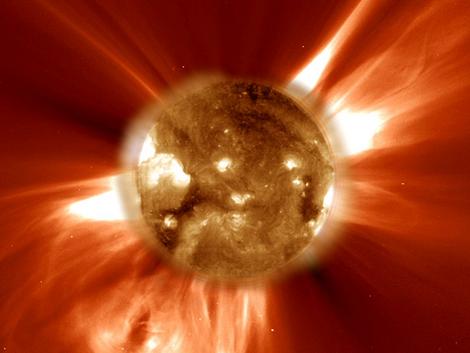The Solar System’s Dark Matter Capture Mechanism
The Sun could be the best place to look for dark matter – the invisible ‘stuff’ that is thought to make up about 83% of the matter in the Universe.
That’s what new Oxford University research reported in a recent Physical Review Letters suggests.
The work looks at the possibility that dark matter is much lighter than the WIMP particles most dark matter hunters are looking for. Such ‘heavy’ particles are also their own antiparticles, so that when a WIMP meets a WIMP they annihilate each other, making it puzzling that there’s still so much dark matter around.
The Oxford team ask: what if, instead of being 100 times the mass of a proton, dark matter particles were only 5 times heavier than a proton but had the same asymmetry – excess of particles over antiparticles?
‘If it were five times heavier, it would get five times the abundance. That’s what dark matter is,’ Subir Sarkar of Oxford University’s Rudolf Peierls Centre for Theoretical Physics, who led the work with Mads Frandsen, told Wired.com’s Lisa Grossman. ‘That’s the simplest explanation for dark matter in my view.’
Because these ‘light’ dark matter particles don’t annihilate each other, Subir and Mads explain, they could be hoovered up by the gravity of a star like our Sun and trapped there.
Subir comments: ‘The sun has been whizzing around the galaxy for 5 billion years, sweeping up all the dark matter as it goes.’

The idea that the Sun acts as a cage for a large amount of dark matter could help to solve a long-standing mystery of solar physics – how the Sun transports heat from its core to the surface so fast when photons and ordinary particles should be colliding with each other, slowing the process down.
Dark matter particles inside the Sun interact very weakly with ordinary matter (but more strongly with each other) and can transport heat to the surface in a novel manner.
‘When we do the calculation, it turns out that this effect may help to solve the solar composition problem,’ Subir reveals.
Even better, calculations of what this component of dark matter would do to neutrinos given off by the Sun indicate that its effect would be detectable by two upcoming experiments: Borexino and SNO+.
‘We know protons make up most of the luminous matter in the universe and, as opposed to many other particles, we know the origin of the proton mass and why it is stable,’ Mads tells me. ‘So it really is a simple and intuitive idea that dark matter would share properties with the proton. Instead the WIMP type candidates in fact are nothing like the proton.’
Subir adds: ‘It’s a speculative idea, but it’s testable. And the tools to test it are coming on line pretty fast. We don’t have to wait 20 years.’
This article is republished from PhysORG under a Creative Commons license. Read the original article.*
Do not forget to share your opinion with us to provide you with the best posts !



0 Comments